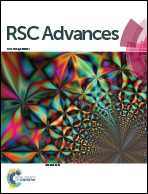Ultrasensitive sensing performances to sub-ppb level acetone for Pd-functionalized SmFeO3 packed powder sensors
Abstract
Pd-SmFeO3 is functionalized by mixing PdCl2 with nanocrystalline powders and subsequently followed by an annealing at 750 °C. With an increasing amount of Pd2+ in composite powders, the sensing response Rg/Ra for low concentration acetone for Pd-doped SmFeO3 sensors increases at first, reaching a maximum with 3 wt% PdCl2 dopant, and then decreases again. The response for undoped SmFeO3 at 240 °C is 2.26 to 500 ppb acetone, whereas the response for 3 wt% Pd-SmFeO3 at 240 °C is 7.21 to 500 ppb acetone. The 3 wt% Pd-doped SmFeO3 sensor at 240 °C shows a short response time (8 s) and recovery time (15 s) to 500 ppb acetone gas, respectively. Such results show that 3 wt% Pd-doped SmFeO3 sensor is a new promising sensing candidate for detecting low concentrations of acetone. Cross-response to relative humidity has also been considered. With increase of relative humidity (RH), there was a slight reduction in response. When the relative humidity is 80% RH, 3 wt% Pd-SmFeO3 to 500 ppb acetone response is 3.25. The superior response and response to acetone gas offer a potential platform for application in diabetes diagnosis.


 Please wait while we load your content...
Please wait while we load your content...